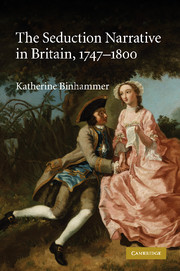Book contents
- Frontmatter
- Contents
- Acknowledgments
- Introduction
- 1 Knowing love: The epistemology of Clarissa
- 2 The whore's love or the Magdalen's seduction
- 3 After knowledge: Married heroines and seduction
- 4 Seduction in street literature
- 5 Melodramatic seduction: 1790s fiction and the excess of the real
- Notes
- Bibliography
- Index
3 - After knowledge: Married heroines and seduction
Published online by Cambridge University Press: 18 February 2010
- Frontmatter
- Contents
- Acknowledgments
- Introduction
- 1 Knowing love: The epistemology of Clarissa
- 2 The whore's love or the Magdalen's seduction
- 3 After knowledge: Married heroines and seduction
- 4 Seduction in street literature
- 5 Melodramatic seduction: 1790s fiction and the excess of the real
- Notes
- Bibliography
- Index
Summary
The first sentence of Henry Fielding's Amelia (1751) announces the life of a marriage as its plot: “The various accidents which befel a very worthy couple, after their uniting in the state of matrimony, will be the subject of the following history.” The novel, however, curiously commences, not with the story of a wife, but with an embedded tale of seduction. Why does the plot of life-after-marriage begin with Miss Mathews's story of seduction? Amelia is not the only novel in the second half of the eighteenth century that both takes the history of a marriage as its primary focus and centrally includes an embedded narrative of seduction. This chapter analyzes three such novels – Fielding's Amelia, Frances Sheridan's Memoirs of Miss Sidney Bidulph (1761) and Elizabeth Griffith's The History of Lady Barton (1771). My interest lies in the relation between the ostensibly extraneous digression into a seduction tale and the stated primary plot of the eponymous heroine's life after marriage. What place does seduction have in the lives of wives? Married women, by definition, are no longer sexually innocent and their erotic knowledge renders them beyond the power of seduction. For this reason, married heroines who are also victims of seduction are rare, yet seduction, I argue, is central to their stories. Wives are frequently the sympathetic listeners to other women's seduction tales and this chapter reads these scenes of story-telling to think about what the embedded narratives add to the primary tale.
- Type
- Chapter
- Information
- The Seduction Narrative in Britain, 1747–1800 , pp. 72 - 107Publisher: Cambridge University PressPrint publication year: 2009



